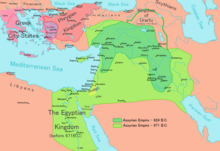
Back الحرب الميدو بابلية ضد الإمبراطورية الآشورية Arabic تسخیر امپراتوری آشور توسط پادشاهی ماد و امپراتوری بابل Persian Chute de l'empire assyrien French Conquista medo-babilonese dell'Impero assiro Italian Conquista medo-babilônica do Império Assírio Portuguese Cucerirea medo-babiloneană a Imperiului Asirian Romanian Medo-babyloniska erövringen av det assyriska imperiet Swedish
| Medo-Babylonian conquest of the Assyrian Empire | |||||||
|---|---|---|---|---|---|---|---|
 Map of the Neo-Assyrian Empire in 824 BC (dark green) and in its apex in 671 BC (light green), under King Esarhaddon | |||||||
| |||||||
| Belligerents | |||||||
|
Medes Babylonians |
Assyrians Egypt | ||||||
| Commanders and leaders | |||||||
|
Cyaxares Nabopolassar |
Sinsharishkun † Ashur-uballit II †(?) Necho II | ||||||
| Strength | |||||||
| 10,000 | 40,000 | ||||||
The Medo-Babylonian conquest of the Assyrian Empire was the last war fought by the Neo-Assyrian Empire, between 626 and 609 BC. Succeeding his brother Ashur-etil-ilani (r. 631–627 BC), the new king of Assyria, Sinsharishkun (r. 627–612 BC), immediately faced the revolt of one of his brother's chief generals, Sin-shumu-lishir, who attempted to usurp the throne for himself. Though this threat was dealt with relatively quickly, the instability caused by the brief civil war may have made it possible for another official or general, Nabopolassar (r. c. 626 – 605 BC), to rise up and seize power in Babylonia. Sinsharishkun's inability to defeat Nabopolassar, despite repeated attempts over the course of several years, allowed Nabopolassar to consolidate power and form the Neo-Babylonian Empire, restoring Babylonian independence after more than a century of Assyrian rule. The Neo-Babylonian Empire, and the newly-formed Median Empire under King Cyaxares (r. 625–585 BC), then invaded the Assyrian heartland. In 614 BC, the Medes captured and sacked Assur, the ceremonial and religious heart of the Assyrian Empire, and in 612 BC, their combined armies attacked and razed Nineveh, the Assyrian capital. Sinsharishkun's fate is unknown but it is assumed that he died in the defense of his capital. He was succeeded as king only by Ashur-uballit II (r. 612–609 BC), possibly his son, who rallied what remained of the Assyrian army at the city of Harran and, bolstered by an alliance with Egypt, ruled for three years, in a last attempt to resist the Medo-Babylonian invasion of his realm.
- ^ Liverani 2013, p. 539.
- ^ Frahm 2017, p. 192.
- ^ Curtis 2009, p. 37.